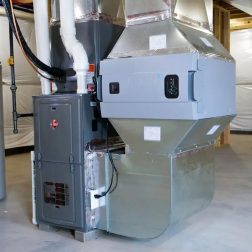Air is one of the greatest routes of exposure we face. As we spend 90% of our time indoors, the health of these environments matters.
If you’re wondering how to improve indoor air quality, this guide walks you through 10 steps to improve your indoor air and offers expert tips. Cleaner indoor air can help prevent and lessen health problems and boost your quality of life. We often live in unhealthy environments and do not realize it until we experience health problems like headaches or breathing issues. Improving your indoor air quality cuts down on triggers for conditions like asthma and allergies and can help you live better.
Signs of Poor Air Quality
If your home has poor air quality, you may not know it. But there are some warning signs you can watch for, especially with your health.
“Signs of poor air quality are not always obvious,” says Andrew Pace, founder of the Green Design Center. “If your home is showing excessive dust after you just cleaned, you notice stale air when you walk in the home, and if you are experiencing fatigue, respiratory issues, and or headaches, I would begin to look at solutions to improve the air quality.”
Some other indications of poor air quality are noticeable odors, visible microbial growth, adverse health reactions with no apparent underlying cause, and constantly dirty air filters, says Michael Rubino, mold and air quality expert, founder of HomeCleanse, and president of Change the Air Foundation.
Read the full article here: https://www.runstreet.com/blog/how-to-improve-indoor-air-quality
Must-Have Indoor Air Quality Tools
-

EC3 Laundry Additive
Add EC3 to every rinse cycle to rinse away mold, bacteria and musty odors from...
-
$23.00 SHOP NOW -
Sale

Intellipure Compact Air Purifier
Buy one Compact, get one free. Simply add one to your cart, and a second...
-
Original price was: $299.00.$199.00Current price is: $199.00. SHOP NOW -

Intellipure SuperV Whole House Air Purifier
Turn your HVAC into a filtration system, removing 99% of ultrafine particles including airborne mold,...
-
$2,000.00 – $2,995.00 SHOP NOW -

HomeCleanse Cleaning
Take your cleaning to the next level buying all the tools we use to keep...
-
$299.00 – $549.00 SHOP NOW -

Mold & Bacteria Contents Cleaning
Remove harmful pollutants that accumulate in the dust of your home. (Options available for renters...
-
$99.00 – $349.00 SHOP NOW -

EC3 Mold Solution Concentrate
Micro Balance EC3 Mold Solution Concentrate is a natural botanical that removes mold spores, bacteria,...
-
$33.00 SHOP NOW -
Sale

Industry-Leading Intellipure Ultrafine 468
The Intellipure® Ultrafine 468 features our proprietary DFS technology, which traps and eliminates potentially harmful...
-
Original price was: $999.00.$499.00Current price is: $499.00. SHOP NOW -

The Dust Test
The Dust Test is a comprehensive at-home test that helps you identify mold and toxins...
-
$274.00 SHOP NOW -
Sale

EuroClean 4 Gallon Hepa Vacuum
The Euroclean GD930HSP is a 4 Gallon Dry HEPA Vacuum that meets the EPA's standards...
-
Original price was: $849.00.$619.00Current price is: $619.00. SHOP NOW -

AprilAire E080 Professional Dehumidifier Bundle
Includes all the dehumidifier accessories you will need. Our Aprilaire E080 comes with a drain...
-
$1,499.99 SHOP NOW
